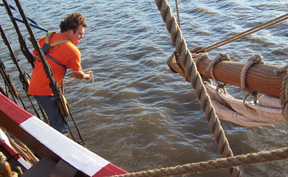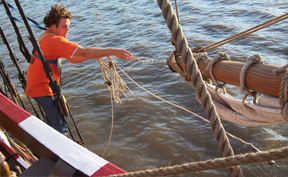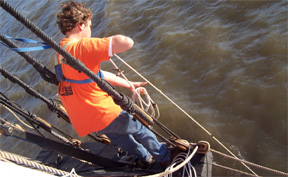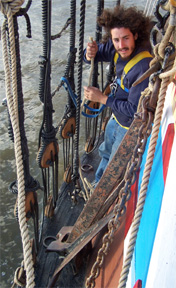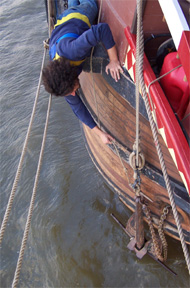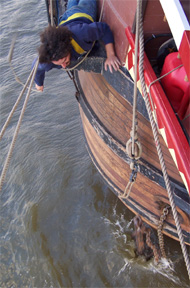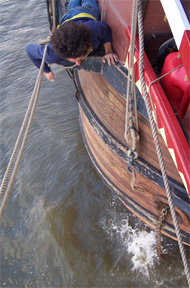 |
||
|
Tuesday October 18, 2005 |
||
Morning Position |
Midday Position |
Evening Position |
Quicklinks |
||
0600 hours: Our day begins. |
1130 hours: Charting position. |
1500 hours: Set sail! |
|
||
0700: Now that everyone is up and about, we weigh anchor. Unfortunately, the anchor comes up upside down, having apparently snagged its own chain. This is a serious problem, so the crew hustles to turn it upright again. Making matters worse, a chiling southerly wind keeps blowing waves up onto Mr. Colley and Mr. Dawson as they work on the beak and the channel. Unfortunately, we don't have any pictures -- that's the problem with real excitement; everyone has something to do! Suffice to say, the crew eventually sets the anchor right and lashes it safely in its place on the starboard fore channel. |
||
Now that the morning has calmed down a little, some students take time to enjoy the scenery. The riverside foliage bursts into autumn color at this time of year. |
||
Other students opt for a quick catnap. But no one can rest too long, because there's still much to be done. |
||
0845: Harness training begins for our student crew. Harness training is required for everyone on board, and is the first step toward climbing aloft. |
||
1130: As we motor down the river, our educational crew brings out a variety of scientific instruments for the students to examine. The students will need to familiarize themselves with these tools for their group presentations. The students also continue learning how to read nautical charts. By plotting our course to determine the distance we need to travel and applying our average speed, they formulate accurate estimates of when we will arrival at Haverstraw Bay. |
||
1400: The students also spend time today learning their knots, an important element of sail handling. The Colleys particularly love teaching students to tie square knots, bowlines, and half hitches. |
||
1430: We've passed Newburgh and Poughkeepsie, and are now approaching Pollepel Island, gateway to a deep, narrow section of the river known as the Hudson Highlands. Pollepal Island has a storied history that extends even beyond Hudson's 1609 voyage of exploration. The local native population believed this island to be home to evil spirits, and thus avoided it. For that reason, the island became a refuge for Dutch explorers and trappers in the early days of the New Netherland Colony. For a brief period in the mid-20th century, plans were even afoot to turn Pollepal Island into a museum dedicated to Henry Hudson's expedition. Pollepal Island is better known to many as Bannerman's Island, thanks to its most famous former owner, a self-promoting 19th century arms dealer (specializing in civil war surplus) who built an armory and private home here in the style of a Scottish castle. Fire swept through the island several decades ago, but the gutted castle remains a scenic ruin to this day, easily visible to anyone taking the train between Albany and New York. Beyond Pollepal Island, we enter the highlands and soon pass West Point. |
||
While working the masts, our crew also continue to refine their belaying and coiling skills. When working the sails, untended lines can quickly cover the deck in a tangle of "spaghetti soup" unless the crew takes care to keep everything ship-shape. |
||
1700: We've reached Haverstraw Bay, just south of Peekskill, where we intend to set anchor for the night. As the ship moves into position, Nick stands lookout on the fore deck. This is no mere busy work; the lookout is the only person who can see river traffic or obstacles in front of the ship, such as the big hunk of driftwood below. Due to the technological limitations of the whipstaff, the helmsman's foreward view is blocked by the fo'c'stle.
Thus, sailing the Half Moon without a lookout would be like driving a car with the windshield blacked out. |
||
|
||
| As we move into position, Mr. Morel steps out onto the port fore channel to continuously take soundings. We're looking for water between three and four fathoms deep (and we especially need to make sure we don't wander into water less than two fathoms in depth). |
||
Meanwhile, Mr. Colley takes position out on the starboard fore channel to lower the anchor, along with the help of additional crew working the tackles on the fore deck. As we near our desired spot, we use the tackles to lower the anchor to the water line. Then, once we're in position, the order is given: "Let fall the anchor!" |
||
Mr. Colley yanks out the wooden "carrot" holding the anchor in place. The anchor disappears with a splash and plummets to the bottom, pulling the anchor rode (line) down with it. |
||
Everything has gone according to plan, and we look forward to spending the evening here in Haverstraw Bay, just around the bend from our eventual, final destination in Verplanck. |
||
1730: But there's a problem. For whatever reason, the river mud at the bottom is particularly soft -- one crew member later says it has a consistency like grease -- and Captain Reynolds can immediately tell that we're dragging the anchor -- the exact problem our crew monitors against during anchor watch each night. In a sense, we've hit a mirror of the problem Hudson and his crew had at this point on their voyage south (see the journal entry below). Where they were temporarily mired in ooze, our problem is that ooze won't let us stay put. This simply will not do. Captain Reynolds summons the crew to the capstan to explain the situation -- we cannot anchor at our current position. First, we must weigh the anchor again. Then we'll decide on our next step. |
||
The adult crew is dispatched to the orlop deck to attach a tagline to the anchor rode and keep it secure (this will save us having to reset the entire anchor rode, which is hundreds of feet long). Meanwhile, the student crew puts their backs into the capstan yet again. In short order, we pull the anchor back up and are ready to set it again. |
||
But before we do that, just as the sun is disappearing behind the horizon, Captain Reynolds has a proposal for the crew. Since we have to relocate anyway, we have a few options open to us. One choice is to move less than a mile down the river, keeping us in the same general area. The other option is to keep on going south and head for the New York City harbor. The downside of the latter plan is that the extra travel time would mean we probably won't get to set the sails again, but that doesn't seem to dissuade the students. They're sent off to discuss what they want to do, but return after just a few moments to deliver their unanimous decision: Carry on to New York City! We continue motoring south, and soon have dinner by starlight. After dinner, the students retreat to the orlop deck to update their journals. |
||
Messages in a BottleCaptain Reynolds writes: We encourage questions from classrooms and individuals; we cannot respond individually, but will post on our web pages answers to questions of general interest. Keep those calls and letters coming. A teacher in Upstate New York asked how it is possible for students to keep up with their studies when they are so busy sailing the ship? Good question! Sailing the ship is demanding, with many important jobs to be done 24 hours a day (yes, the crew stands anchor watch through the night). Aboard the Half Moon we organize around studies that Hudson and his crew would have pursued. This helps integrate the studies into the normal work. For example, we will measure and calculate the speed of currents or the speed of the ship. This requires measuring the time it takes a chip of wood to pass a known distance on the ship, and then convert that speed (measured in seconds per 30 feet) into nautical miles per hour. Hudson also paid much attention to tides, and students aboard the ship measure the depth of water, and plot tidal curves. This is necessary for the safe operation of the ship, and gives the students insight about the natural world. The ship will also anchor for a full day in one location. This allows the students to complete in-depth studies of a range of topics. Each student will select a research topic, collect data on that particular topic, plot the data in a graph, and then make a presentation to the crew about their findings. It is a lot of work. Students have studied topics ranging from the changing altitude of celestial objects, to tidal depth curves, to dissolved oxygen content in the water column, to correlations of wind speed between the top of the mast and the deck. Being in the field, working with real-world data and producing useful results is a great incentive to the students to work hard and tackle tough questions. And it is amazing how fun it can be to do this research. Another question came in from a concerned parent about the food on board the ship. Our cooks, that being Mrs. Anita Brudos on this voyage, go to great pains to prepare wholesome, nutritious foods in good quantities. Just as Hudson had to be concerned about an adequate diet, so do we. First off, hard work in the outdoors tends to build appetites. Cooks on the Voyage of Discovery turn out meals for two dozen people the equivalent of four times a day, including our anchor watch snacks. These meals need to be nutritionally balanced and tasty. We always have a variety of fruits and vegetables, and pleasing choices of proteins and carbohydrates. The crew on the Half Moon also needs to stay hydrated, so we ensure plenty of drinking water. Clean plates all around are the best evidence of Mrs. Brudos’ creative cooking. Another concerned parent wanted to know how we stay warm. The Half Moon looks and operates just as the original ship from 1609. Naturally, few sources of heat existed on the original ship, and few do here. Hudson’s crew did stop to collect firewood in the Faroe Islands before crossing the Atlantic. Beyond that, about all they had was clothing and body heat. We also have no formal heating system; crew keep warm with their clothing, and by staying below of the wind. It can get nippy standing look-out, exposed to the wind and rain, but if a student forgets their rain gear, we have a well-supplied slop chest with left-behind-clothing from previous voyages. Our officers also keep an eye out for signs of weariness and cold, and will rotate crew who appear to be affected. |
||
|
||
One Day after Departure, 1609: The foure and twentieth was faire weather: the winde at the North-west, wee weighed, and went downe the River seven or eight leagues; and at halfe ebbe wee came on ground on a banke of Oze in the middle of the River, and sate there till the floud. Then wee went on Land, and gathered good store of Chest-nuts. At ten of the clocke wee came off into deepe water, and anchored. -- Robert Juet's Journal. |
||
|
||
